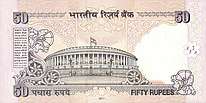Indian 50-rupee note
The (₹50) is a denomination of the Indian rupee. The present ₹50 banknote in circulation is a part of the Mahatma Gandhi New Series of banknotes. However, ₹50 banknotes of the previous series (Mahatma Gandhi Series) will continue to be legal tender.[2]
| (India) | |
|---|---|
| Value | ₹50 (approx. $0.77) |
| Width | 135 mm |
| Height | 66 mm |
| Security features | Security thread, latent image, micro-lettering, intaglio print, fluorescent ink, watermark, and see through registration device.[1] |
| Years of printing | August 2017 - present |
| Obverse | |
 | |
| Design | Mahatma Gandhi |
| Designer | Reserve Bank of India |
| Design date | 2017 |
| Reverse | |
 | |
| Design | Hampi with Chariot |
| Designer | Reserve Bank of India |
| Design date | 2017 |
The ₹50 banknote denomination was first introduced by the Reserve Bank of India (RBI) in 1975 as a part of the Lion Capital Series, which had the Ashoka pillar on the banknote. It was replaced by a watermark of Mahatma Gandhi in the Mahatma Gandhi Series, in 1996.[3]
Mahatma Gandhi New Series
On 10 November 2016, the Reserve Bank of India announced, a new redesigned ₹50 banknote was to be available as a part of the Mahatma Gandhi New Series.[4] The note was officially announced on 18 August 2017 and now on circulation.[5] On 18 August 2017, the Reserve Bank of India introduced a new ₹50 banknote in the Mahatma Gandhi (New) Series. However, ₹50 banknotes of the previous series will continue to be legal tender.[6]
Design
The new version of the note has a depiction of Hampi with Chariot on the reverse, depicting the country’s cultural heritage. The base colour of the note is Fluorescent blue. The note has other designs, geometric patterns aligning with the overall colour scheme, both at the obverse and reverse.[7] The dimensions of the banknote are measured at 135 mm × 66 mm.[8]
History
Lion capital series

The ₹50 banknote in the Lion capital series was the highest denomination.
Design
The obverse design included the Lion Capital. The reverse design included an image of the Sansad Bhawan.
Mahatma Gandhi Series


Design
As of 2012, the new ₹ sign has been incorporated in revised versions of the ₹50 note.[9] In January 2014 RBI announced that it would be withdrawing from circulation all banknotes printed prior to 2005 by 31 March 2014. The deadline was later extended to 1 January 2015, then to 30 June 2016.[10]
Security features
The security features of the ₹50 banknote includes:[11]
- A windowed security thread that reads 'भारत' (Bharat in the Devanagari script) and 'RBI' alternately.
- Latent image of the value of the banknote on the vertical band next to the right hand side of Mahatma Gandhi’s portrait.
- Watermark of Gandhi that is a mirror image of the main portrait.
- The number panel of the banknote is printed in embedded fluorescent fibers and optically variable ink.
- Since 2005 additional security features like machine-readable security thread, electrotype watermark, and year of print appears on the bank note.
Languages
Like the other Indian rupee banknotes, the ₹50 banknote has its amount written in 17 languages. On the obverse, the denomination is written in English and Hindi. On the reverse is a language panel which displays the denomination of the note in 15 of the 22 official languages of India. The languages are displayed in alphabetical order. Languages included on the panel are Assamese, Bengali, Gujarati, Kannada, Kashmiri, Konkani, Malayalam, Marathi, Nepali, Odia, Punjabi, Sanskrit, Tamil, Telugu and Urdu.
| Denominations in central level official languages (At below either ends) | |||||||||||
|---|---|---|---|---|---|---|---|---|---|---|---|
| Language | ₹50 | ||||||||||
| English | Fifty rupees | ||||||||||
| Hindi | पचास रुपये | ||||||||||
| Denominations in 15 state level/other official languages (As seen on the language panel) | |||||||||||
| Assamese | পঞ্চাশ টকা | ||||||||||
| Bengali | পঞ্চাশ টাকা | ||||||||||
| Gujarati | પચાસ રૂપિયા | ||||||||||
| Kannada | ಐವತ್ತು ರುಪಾಯಿಗಳು | ||||||||||
| Kashmiri | پاژاھ رۄپے | ||||||||||
| Konkani | पन्नास रुपया | ||||||||||
| Malayalam | അൻപതു രൂപ | ||||||||||
| Marathi | पन्नास रुपये | ||||||||||
| Nepali | पचास रुपियाँ | ||||||||||
| Odia | ପଚାଶ ଟଙ୍କା | ||||||||||
| Punjabi | ਪੰਜਾਹ ਰੁਪਏ | ||||||||||
| Sanskrit | पञ्चाशत् रूप्यकाणि | ||||||||||
| Tamil | ஐம்பது ரூபாய் | ||||||||||
| Telugu | యాభై రూపాయలు | ||||||||||
| Urdu | پچاس روپے | ||||||||||
References
- "Are there any special features in the banknotes of Mahatma Gandhi series- 1996?". Your Guide to Money Matters. Reserve Bank of India. Archived from the original on 12 January 2012. Retrieved 11 January 2012.
- "Yes, RBI will shortly issue new Rs 50 currency note". Indian Express.
- Republic India Issues Reserve Bank of India.
- RBI to issue ₹1,000, ₹100, ₹50 with new features, design in coming months
- https://www.rbi.org.in/Scripts/BS_PressReleaseDisplay.aspx?prid=41412
- "Yes, RBI will shortly issue new Rs 50 currency note". Indian Express.
- "RBI Introduces 50 banknote in Mahatma Gandhi (New) Series". Reserve Bank of India. 18 August 2017. Retrieved 18 August 2017.
- "RBI announces new Rs 50 currency note, here's how it looks like". Economic Times.
- "Issue of ₹20/- and ₹50/- denomination Bank notes without inset letter and with ₹ symbol". RBI. Retrieved 12 April 2012.
- "Withdrawal of Currencies Issued Prior to 2005". Press Information Bureau. 25 July 2014. Retrieved 25 July 2014.
- RBI - ₹50 security features